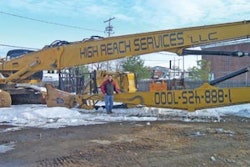Few concrete contractors know how to track job costs effectively. Very few. The reason few do is very simple: job costing is extremely difficult to get right. Would you like to learn how to do it right? Then read on.
In my many years of helping contractors with their job costing, I have discovered that over 80 percent of them are aiming for the wrong target. Most focus their attention on whether each job made money, and why not? Accounting systems are designed to do that very thing.
Ask your bookkeeper to pull up the charges for a job and he or she will pop out a little job costing report that details the payroll charges and supplier charges (concrete, rock, trucking, etc.) that have been assigned to the job.
What's wrong with that report? Number one, you're not seeing the full costs associated with the job. Number two, the costs of a specific job are nowhere near as important as knowing your crew's average performance across all jobs. As long as your job costing system tracks dollars and only dollars you will never collect the information you need to:
- Estimate accurately
- Consistently finish jobs on time
- Know whether your crews are working as fast as they should
Would you like a quick tip to help you boost the usefulness of your job costing system? Change your mind set from job costing to job tracking. You need to track all of the important information produced by the job. Most of that data is not financial, so you need to concentrate on building a system that tracks critical job information.
Few pieces of information have greater value than knowing the speed at which your crews work - how many cubic yards do your crews install per man-hour? Having that knowledge is like having money in the bank. And the only way you get that knowledge is by installing a job costing system that tracks non-financial numbers.
Let's dive in with "concrete" examples.
Concrete contractors should track the labor hours spent on critical tasks - the time it takes field workers to prep, form, pour and finish concrete. The second item you should track is the quantity of work accomplished: linear feet or square feet of forming, cubic yards or square feet of pouring and finishing, the number of footers installed, etc. Combining the two pieces of data lets you calculate the amount of work per man-hour.
Now that you understand the real goal of job costing - to track both financial and non-financial performance - your next hurdle is to create a job costing system that your personnel can actually use.
KISS - Keep it short and simple
Short means you track the absolute minimum information you need to estimate accurately and monitor field performance.
Simple means your employees can collect the data and fill out the paperwork. You need to install a job costing system that delivers the goods without being overbearing to your people. It is difficult but not impossible.
Another saying to keep in mind is "crawl before you walk and walk before you run." When you first venture into job costing, start with a fairly simple list of cost codes, a fairly simple time sheet and fairly simple data storage. Everyone will need to get comfortable and skilled at a simple system before you can start dialing up the complexity of your cost tracking.
Cost codes
Ask your field workers to break their time into too many cost codes and they will respond by recording it to whatever they think they should have been spending their time on. In other words, the information will be junk.
To minimize the burden on your field workers, keep the data collection reasonable. Go after the tasks that account for 80 percent of the crew's time. You will discover that roughly 20 percent of their tasks account for over 80 percent of their time. Don't sweat the 80 percent of tasks that only account for 20 percent of the time. The big hitters are the only tasks your crews should be coding their time to. All other time should be coded to "Other."
Here's a fairly thorough list of the tasks a concrete crew might perform. Which three or four are taking up the vast majority of your crews' time?
- Demolition
- Compaction of ground
- Layout
- Installing forms
- Installing expansion material
- Placing rock
- Placing rebar or wire
- Transporting concrete
- Pouring concrete
- Troweling concrete
- Saw cutting concrete
- Covering concrete
- Removing forms
Size of job matters when it comes to choosing your cost codes. If your crew is working on small areas like footings, they will probably do several in one day and may hit more than one site per day. If they are working on a large job, they may work on the same task, like forming, for many days in a row. Coding time is much easier on jobs that run several days than it is on jobs that run several hours. A simple rule of thumb: an employee should be able to record all of one day's time on no more than four real codes and "Other."
If your typical job runs less than one day and you have crews of less than four people, the workers should probably track their time by preparation, pouring, finishing and mobilization. If your crews tend to spend three or four days on one job, then your workers should probably track their time by all of the tasks listed above. The right answer will differ by the type of jobs you typically have.
Once you've figured out which tasks to track, create a master list of the codes and assign numbers to them. For each job, narrow the list down to the codes you want them to track their time to. Give your foremen the list of codes complete with clear descriptions of what tasks are to be assigned to each code.
Tracking work output
In order to calculate labor productivity (i.e. the speed at which your crews work) you must know how much work the crew performed. You MUST track the quantity of work produced. Examples are:
- Square feet of slab poured and finished
- Cubic yards of grade beams poured
- Lineal feet of slab forms installed
- Square feet of wall forms installed
- Pounds of rock spread and compacted
- Number of rebar rods tied and placed
- Square feet of wire grid placed
- Lineal feet of expansion joint place
- Cubic yards of debris removed
On small jobs, much of this data can come from the original estimate. On large, multi-day jobs, daily progress (quantities) must be tracked. It's best not to have the field workers track data that can be captured in the office from existing documents unless it is needed to ensure they are making adequate daily progress.
Time card design
Redo your time sheets to make them user-friendly. The less writing the foremen need to do, the better. Consider printing out custom time sheets for each job that contain the project information and the material quantities required for the job. You will quickly discover that the easier the data recording, the better data you'll receive.
Non-negotiable: time cards must be filled out daily!
Data quality drops off rapidly when crews are allowed to fill out their cards a few days down the road. Give each worker a pocket-sized spiral notebook to jot down their coded time throughout the day. Then they, or their foreman, can transfer their notes to the time sheet at the end of the day.
Crew training
The final step is teaching your field crews and foremen how to fill out the paperwork. Give them examples. Have them fill out a couple of time cards together in your office. Provoke questions and answer them.
We all know how much the field workers HATE paperwork. If they liked paper work, they would have become desk jockeys. You need to sell your employees on the value of sending in accurate data.
Explain that the data is essential for setting realistic budgets and schedules. Explain that their personal financial security is tied to you knowing their productivity. After you've answered the "What's in it for me?" question, hold your foremen accountable for submitting complete and accurate time sheets. Job costing is not quite as important as safety, but it sure runs a close second.
Data storage & analysis
Most contractors discover that storing job cost data in a spreadsheet is by far easier than trying to work within the constraints of their accounting systems. Accounting packages are not designed to let you analyze data across multiple projects. If you do store your data in your accounting system, export it to a spreadsheet before trying to analyze it.
Once in the spreadsheet, group and sort the data. Put it into charts and tables (have someone set up Pivot Tables, they're a great tool for this task). Look for trends and averages. Update your estimating and scheduling based on the results your information reveals.
Conclusion
Job costing is a hot button with contractors. If you don't know how fast your crews work, sooner or later you are going to dig yourself a financial hole that is very difficult to crawl out of.
If you want your concrete construction business to produce a predictable profit, you must accept the headaches associated with job costing. Job costing systems are very, very difficult to get right. Unfortunately, they are also essential to survival in the construction industry!



















